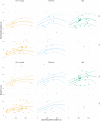Baleen whale inhalation variability revealed using animal-borne video tags
- PMID: 35880219
- PMCID: PMC9308462
- DOI: 10.7717/peerj.13724
Baleen whale inhalation variability revealed using animal-borne video tags
Abstract
Empirical metabolic rate and oxygen consumption estimates for free-ranging whales have been limited to counting respiratory events at the surface. Because these observations were limited and generally viewed from afar, variability in respiratory properties was unknown and oxygen consumption estimates assumed constant breath-to-breath tidal volume and oxygen uptake. However, evidence suggests that cetaceans in human care vary tidal volume and breathing frequency to meet aerobic demand, which would significantly impact energetic estimates if the findings held in free-ranging species. In this study, we used suction cup-attached video tags positioned posterior to the nares of two humpback whales (Megaptera novaeangliae) and four Antarctic minke whales (Balaenoptera bonaerensis) to measure inhalation duration, relative nares expansion, and maximum nares expansion. Inhalation duration and nares expansion varied between and within initial, middle, and terminal breaths of surface sequences between dives. The initial and middle breaths exhibited the least variability and had the shortest durations and smallest nares expansions. In contrast, terminal breaths were highly variable, with the longest inhalation durations and the largest nares expansions. Our results demonstrate breath-to-breath variability in duration and nares expansion, suggesting differential oxygen exchange in each breath during the surface interval. With future validation, inhalation duration or nares area could be used alongside respiratory frequency to improve oxygen consumption estimates by accounting for breath-to-breath variation in wild whales.
Keywords: Biotelemetry; Nares; Rorqual whales; Ventilation.
©2022 Nazario et al.
Conflict of interest statement
The authors declare there are no competing interests.
Figures





References
-
- Aphalo PJ. Ggpmisc: Miscellaneous Extensions to ‘Ggplot2’. R package version 0.3.3https://cran.r-project.org/web/packages/ggpmisc/index.html 2019

